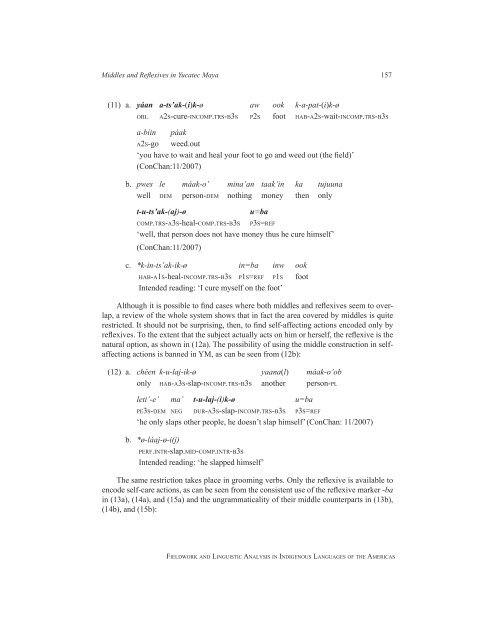Fieldwork and Linguistic Analysis in Indigenous ... - ScholarSpace
Fieldwork and Linguistic Analysis in Indigenous ... - ScholarSpace
Fieldwork and Linguistic Analysis in Indigenous ... - ScholarSpace
You also want an ePaper? Increase the reach of your titles
YUMPU automatically turns print PDFs into web optimized ePapers that Google loves.
Middles <strong>and</strong> Reflexives <strong>in</strong> Yucatec Maya 157<br />
(11) a. yáan a-ts’ak-(i)k-ø aw ook k-a-pat-(i)k-ø<br />
obl a2s-cure-<strong>in</strong>comP.trs-b3s P2s foot hab-a2s-wait-<strong>in</strong>comP.trs-b3s<br />
a-bí<strong>in</strong> páak<br />
a2s-go weed.out<br />
‘you have to wait <strong>and</strong> heal your foot to go <strong>and</strong> weed out (the field)’<br />
(ConChan:11/2007)<br />
b. pwes le máak-o’ m<strong>in</strong>a’an taak’<strong>in</strong> ka tujuuna<br />
well dem person-dem noth<strong>in</strong>g money then only<br />
t-u-ts’ak-(aj)-ø u=ba<br />
comP.trs-a3s-heal-comP.trs-b3s P3s=ref<br />
‘well, that person does not have money thus he cure himself’<br />
(ConChan:11/2007)<br />
c. *k-<strong>in</strong>-ts’ak-ik-ø <strong>in</strong>=ba <strong>in</strong>w ook<br />
hab-a1s-heal-<strong>in</strong>comP.trs-b3s P1s=ref P1s foot<br />
Intended read<strong>in</strong>g: ‘I cure myself on the foot’<br />
Although it is possible to f<strong>in</strong>d cases where both middles <strong>and</strong> reflexives seem to overlap,<br />
a review of the whole system shows that <strong>in</strong> fact the area covered by middles is quite<br />
restricted. It should not be surpris<strong>in</strong>g, then, to f<strong>in</strong>d self-affect<strong>in</strong>g actions encoded only by<br />
reflexives. To the extent that the subject actually acts on him or herself, the reflexive is the<br />
natural option, as shown <strong>in</strong> (12a). The possibility of us<strong>in</strong>g the middle construction <strong>in</strong> selfaffect<strong>in</strong>g<br />
actions is banned <strong>in</strong> YM, as can be seen from (12b):<br />
(12) a. chéen k-u-laj-ik-ø yaana(l) máak-o’ob<br />
only hab-a3s-slap-<strong>in</strong>comP.trs-b3s another person-Pl<br />
leti’-e’ ma’ t-u-laj-(i)k-ø u=ba<br />
Pe3s-dem neg dur-a3s-slap-<strong>in</strong>comP.trs-b3s P3s=ref<br />
‘he only slaps other people, he doesn’t slap himself’ (ConChan: 11/2007)<br />
b. *ø-láaj-ø-i(j)<br />
Perf.<strong>in</strong>tr-slap.mid-comP.<strong>in</strong>tr-b3s<br />
Intended read<strong>in</strong>g: ‘he slapped himself’<br />
The same restriction takes place <strong>in</strong> groom<strong>in</strong>g verbs. Only the reflexive is available to<br />
encode self-care actions, as can be seen from the consistent use of the reflexive marker -ba<br />
<strong>in</strong> (13a), (14a), <strong>and</strong> (15a) <strong>and</strong> the ungrammaticality of their middle counterparts <strong>in</strong> (13b),<br />
(14b), <strong>and</strong> (15b):<br />
fieldwork <strong>and</strong> l<strong>in</strong>guistic analysis <strong>in</strong> <strong>in</strong>digenous languages of the americas

















